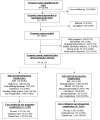Patterns and Determinants of Care-Seeking for Antepartum and Intrapartum Complications in Rural Bangladesh: Results from a Cohort Study
- PMID: 27997537
- PMCID: PMC5172566
- DOI: 10.1371/journal.pone.0167814
Patterns and Determinants of Care-Seeking for Antepartum and Intrapartum Complications in Rural Bangladesh: Results from a Cohort Study
Abstract
Background: The burden of maternal complications during antepartum and intrapartum periods is high and care seeking from a trained provider is low, particularly in low middle income countries of sub-Saharan Africa and South Asia. Identification of barriers to access to trained care and development of strategies to address them will contribute to improvements in maternal health. Using data from a community-based cohort of pregnant women, this study identified the prevalence of antepartum and intrapartum complications and determinants of care-seeking for these complications in rural Bangladesh.
Methods: The study was conducted in 24,274 pregnant women between June 2011 and December 2013 in rural Sylhet district of Bangladesh. Women were interviewed during pregnancy to collect data on demographic and socioeconomic characteristics; prior miscarriages, stillbirths, live births, and neonatal deaths; as well as data on their ability to make decision to go to health center alone. They were interviewed within the first 7 days of child birth to collect data on self-reported antepartum and intrapartum complications and care seeking for those complications. Bivariate analysis was conducted to explore association between predisposing (socio-demographic), enabling (economic), perceived need, and service related factors with care-seeking for self-reported antepartum and intrapartum complications. Multivariable multinomial logistic regression was performed to examine the association of selected factors with care-seeking for self-reported antepartum and intrapartum complications adjusting for co-variates.
Results: Self-reported antepartum and intrapartum complications among women were 14.8% and 20.9% respectively. Among women with any antepartum complication, 58.9% sought care and of these 46.5% received care from a trained provider. Of the women with intrapartum complications, 61.4% sought care and of them 46.5% did so from a trained provider. Care-seeking for both antepartum and intrapartum complications from a trained provider was significantly higher for women with higher household wealth status, higher literacy level of both women and their husbands, and for those living close to a health facility (<10 km). Women's decision making ability to go to health centre alone was associated with untrained care only for antepartum complications, but was associated with both trained and untrained care for intrapartum complications.
Conclusions: Nearly 40.0% of the women who experienced either an antepartum or intrapartum complications did not seek care from any provider and 11.5% -14.9% received care from untrained providers, primarily because of economic and geographic barriers to access. Development and evaluation of context specific, cost-effective, and sustainable strategies that will address these barriers to access to care for the maternal complications will enhance care seeking from trained health care providers and improve maternal health.
Conflict of interest statement
The authors have declared that no competing interests exist.
Figures


References
-
- Alkema L, Chou D, Hogan D, Zhang S, Moller AB, Gemmill A, et al. Global, regional, and national levels and trends in maternal mortality between 1990 and 2015, with scenario-based projections to 2030: a systematic analysis by the UN Maternal Mortality Estimation Inter-Agency Group. Lancet (London, England). 2016;387(10017):462–74. Epub 2015/11/21. - PMC - PubMed
-
- WHO. Trends in maternal mortality:1990 to 2013. Estimates by WHO, UNICEF, UNFPA, The World Bank and the United Nations Population Division. 2014 Accessed online on 30 April 2016. http://apps.who.int/iris/bitstream/10665/112682/2/9789241507226_eng.pdf
-
- WHO. Trends in Maternal Mortality:1990 to 2015. Estimates by WHO, UNICEF, UNFPA, World Bank Group and the United Nations Population Division. 2015 Accessed on 10 July 2016. http://apps.who.int/iris/bitstream/10665/194254/1/9789241565141_eng.pdf
-
- Hogan MC, Foreman KJ, Naghavi M, Ahn SY, Wang M, Makela SM, et al. Maternal mortality for 181 countries, 1980–2008: a systematic analysis of progress towards Millennium Development Goal 5. Lancet (London, England). 2010;375(9726):1609–23. Epub 2010/04/13. - PubMed
MeSH terms
LinkOut - more resources
Full Text Sources
Other Literature Sources
Medical

